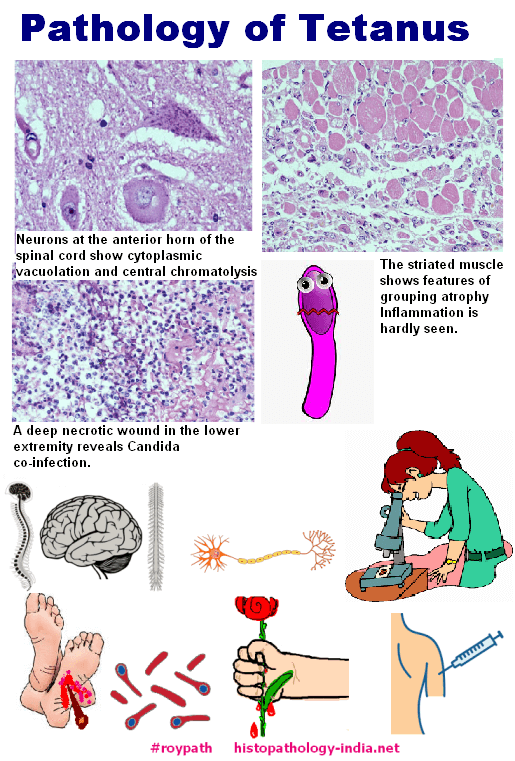|

Custom Search
|
|
Infectious Disease Online Pathology of Tetanus #roypath #pathology #histopathology #tetanus #Clostridiumtetani #lockjaw #bacteria #infectiousdisease #tetanustoxin #tetanuspathology #tetanushistopathology #clostridiumpathology |

| Tetanus is an infection caused by a bacterium called Clostridium tetani. Spores of tetanus bacteria are everywhere in the environment, including soil, dust, and manure. The spores develop into bacteria when they enter the body. Tetanus bacteria are more likely to infect certain breaks in the skin (Eg - wounds caused by an object puncturing the skin (puncture wounds), like a nail or needle or wounds contaminated with dirt). The active anaerobic bacteria lead to the production of a tetanus toxin, which enters the nervous system via lower motor neurons and travels up to the spinal cord and brain stem. Another name for tetanus is “lockjaw”. It often causes a person’s neck and jaw muscles to lock, making it hard to open the mouth or swallow. |
Tetanus (lockjaw) results from the absorption of the potent exotoxin produced by Clostridium tetani. This free-living saprophyte, widespread in nature, especially in cultivated soil, is commonly found in the faeces of cattle and horses and less commonly of humans. It therefore tends to colonize manured areas of cultivation. Once introduced into an area, spores of Clostridium tetani persist almost indefinitely. Tetanus is therefore particularly a hazard in intensively cultivated rural areas. Tetanus results from the introduction of spores of Clostridium tetani into tissue, where anaerobic conditions favorable to germination and toxin production may be present. Punctured wounds as from a nail or splinter are particularly dangerous.
Tetanus was once a frequent complication of abortion and was also commonly seen in infants as tetanus neonatorum , which resulted from the infection of the umbilical stump. Active immunization has contributed to a decline in the occurrence of tetanus. Tetanus toxin is absorbed from the local site of production and is transmitted into the central nervous system along the axons of neurons. Tetanus toxin is a potent neurostimulatory agent. Clinical features of tetanus may appear several weeks or even months after the responsible injury, and in a considerable number of cases no injury can be demonstrated or recalled. Symptoms begin with headache, followed shortly by difficulty in swallowing and stiffness of the jaw. Muscle stiffness or spasm may initially be confined to the region of the local infection (local tetanus). Spasm of the muscles of the trunk may lead to opisthotonos. Contraction of the facial muscles produces the characteristic risus sardonicus. Consciousness is undistributed, and perception of pain is undiminished. Death results from inanition or secondary complications such as bronchopneumonia. Specific morphologic changes have not been described. A reliable diagnostic procedure is the demonstration of muscle spasm in guinea pigs injected with wound scrapings suspended in a saline solution. The presence of tetanus bacilli established by culture is not diagnostic, since spores of C. tetani frequently contaminate wounds.
|
|
|

